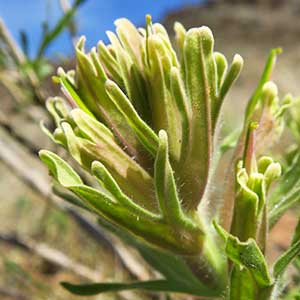Castilleja xanthotricha
Castilleja cervina
John Day or yellow-hairy paintbrush, John Day paintbrush, yellow hair paintbrush, yellow-hair Indian paintbrush
deer Indian paintbrush, deer paintbrush
few to several, ± decumbent to erect or ascending, unbranched, sometimes with short, leafy axillary shoots, hairs erect to spreading, long, soft, eglandular, mixed with short stipitate-glandular ones.
solitary or few to many, erect, branched distally, sometimes unbranched or with short, leafy branches in axils of leaves, glabrous, sometimes hairy, hairs moderately dense, spreading, short, soft, eglandular.
green, linear, lanceolate to broadly lanceolate, oblong, or cuneate, 0.8–5 cm, not fleshy, margins plane to wavy, involute, 0–5-lobed, apex acute, sometimes rounded;
lobes spreading, linear, arising below mid length, nearly as broad as center lobe, apex acute.
green, sometimes purplish, linear or narrowly lanceolate, 1–9 cm, not fleshy, margins plane, involute, 3–5(–9)-lobed, apex acuminate to narrowly acute;
lobes spreading, linear, arising near or below mid length, apex acute, rarely obtuse.
3–14 × 1.5–4.5 cm;
bracts proximally greenish, rarely dull reddish purple, distally white to cream, rarely pale yellow or dull, pale pink (sharply differentiated from proximal coloration), lanceolate or oblong to narrowly ovate, (3–)5–7-lobed;
lobes ascending, linear to obovate, ± broadened distally, medium, long, proximal lobes arising below mid length, central lobe apex broadly rounded to truncate, others acute to rounded.
3–15(–20) × 1.5–3 cm;
bracts proximally pale greenish to pale yellowish green, distally white, cream, or pale yellow, sometimes pale greenish, pale yellow-green, or pale yellow throughout, lanceolate to narrowly elliptic, 3–5(–7)-lobed;
lobes ascending or spreading, linear to very narrowly linear, long, arising above or below mid length, apex acute to obtuse.
curved, 17–23 mm;
tube 15–19 mm;
beak exserted, adaxially green, 5–8(–9) mm, puberulent, stipitate-glandular;
abaxial lip deep purple (color sometimes visible through calyx), green, pinkish, or pale yellow, ± prominent, slightly inflated, usually hidden in calyx, sometimes right at top of calyx, 2 mm, ca. 50% as long as beak;
teeth ascending, whitish, yellowish, pink, or green, 1–1.5 mm.
straight or ± curved, 16–25 mm;
tube 15–17 mm;
beak exserted from calyx, adaxially green, 5–7 mm;
abaxial lip deep green, reduced, exserted through abaxial cleft, 1–4 mm, 40–60% as long as beak;
teeth erect, white, 0.5–1 mm.
colored as bracts, 15–26 mm;
abaxial and adaxial clefts 3.5–7 mm, 25–50% of calyx length, deeper than laterals, lateral 2–5 mm, 12–25% of calyx length;
lobes linear, oblong, or narrowly triangular, center lobe apex usually rounded, lobes acute to rounded.
green, rarely pale purple, lobes white, cream, or pale yellow, 18–24(–27) mm;
abaxial clefts (6–)8–16 mm, adaxial 4–10(–14) mm, abaxial 45–60% of calyx length, adaxial 15–40% of calyx length, deeper than laterals, lateral 1–4 mm, 5–15% of calyx length;
lobes narrowly triangular to linear, apex acute.
= 48.
= 24.
Castilleja xanthotricha
Castilleja cervina
Castilleja xanthotricha is endemic to moderate elevations in the sagebrush hills of the John Day River drainage in north-central Oregon. N. H. Holmgren (1971) hypothesized that this tetraploid species is of allopolyploid hybrid origin between C. glandulifera and C. oresbia.
(Discussion copyrighted by Flora of North America; reprinted with permission.)
Castilleja cervina is found across northern Washington, from the eastern slope of the Cascade Range, east to northern Idaho and north to southern British Columbia. Plants at higher elevations are dwarfed. Reports from Montana need verification.
(Discussion copyrighted by Flora of North America; reprinted with permission.)


